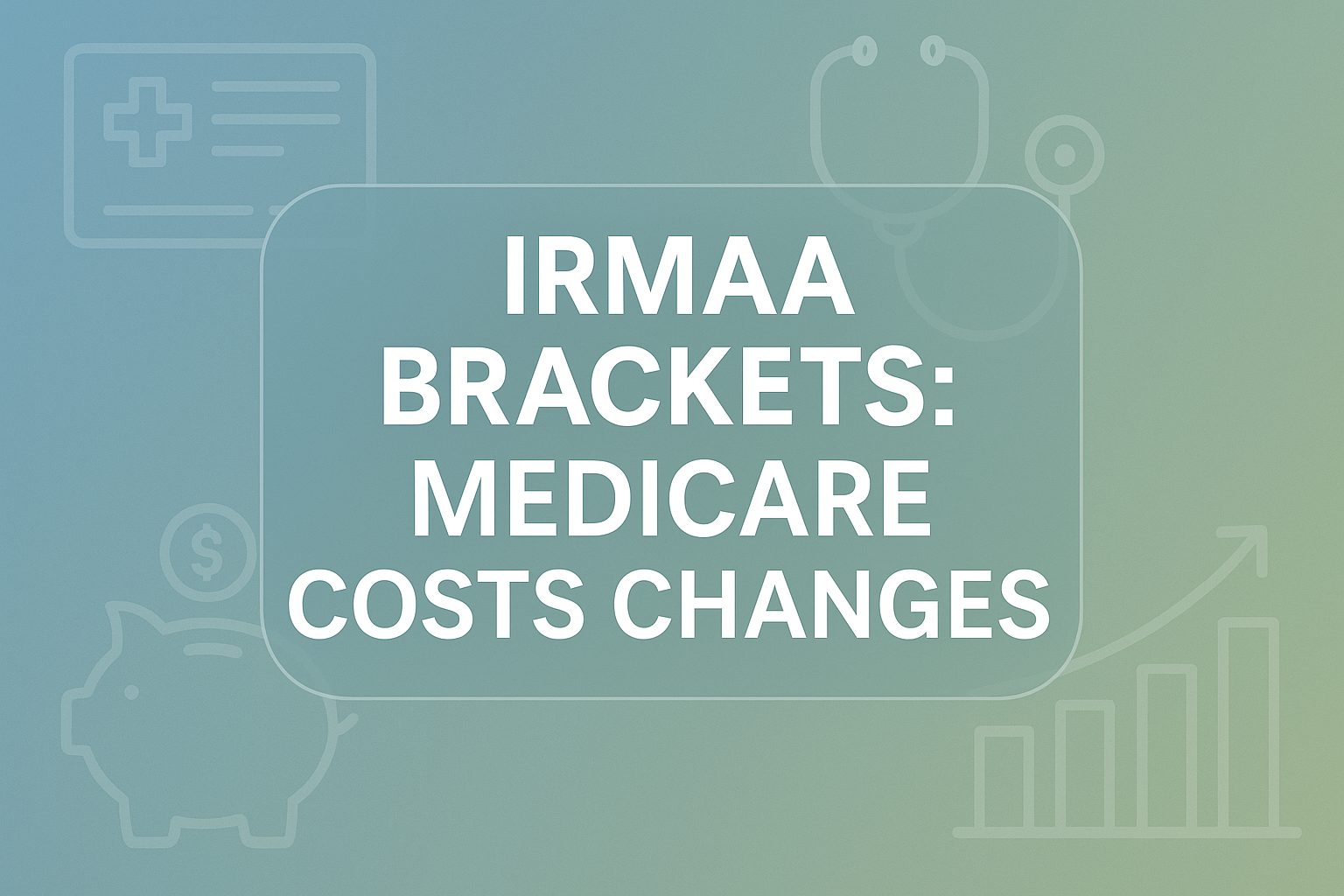2026 IRMAA Brackets: Anticipated Changes to Medicare Costs
Planning for retirement is a big deal for federal employees, particularly those who might find themselves paying extra Medicare premiums because of their income level. This extra premium, known as the Income-Related Monthly Adjustment Amount (IRMAA), can sneak up on you if you’re not prepared. And because of how Medicare calculates it (using a two-year look-back at your income), it’s important to understand that what you earn in 2024 will determine your Medicare costs in 2026.
At PlanWell, we’ve spent decades acting as a dedicated financial advisor for federal employees, mapping out every aspect of their financial life—including unique provisions like IRMAA. Our founders have over 30 years of combined experience, and all of our planners hold the Chartered Federal Employee Benefits Consultant (ChFEBC®), CERTIFIED FINANCIAL PLANNER™ (CFP®), and Accredited Investment Fiduciary® (AIF®) credentials. We’ve also developed the Fed-Expert Financial Blueprint to help active and retired federal workers retire with confidence. One crucial component of that plan is ensuring you’re ahead of any potential IRMAA surprises.
Why IRMAA Matters for High-Earning Federal Retirees
IRMAA isn’t just another acronym. It’s a real monthly surcharge added to your Medicare Part B and Part D premiums if your income exceeds certain thresholds. For a deeper dive into how these surcharges work—as well as tips to keep them in check—see our guide on avoiding higher Medicare Part B premiums and IRMAA surcharges.
Federal retirees are especially susceptible to IRMAA for a few reasons. Some receive substantial FERS annuity payments, may access large TSP withdrawals, or have unused leave payouts that can spike their Modified Adjusted Gross Income (MAGI). In fact, the Social Security Administration (SSA) has reported that more than 8 million beneficiaries pay IRMAA, accounting for billions of dollars in extra premiums each year. Missing a threshold by even a single dollar can bump you into a higher bracket and cost you hundreds—sometimes thousands—of dollars more a year in Medicare premiums.
How the 2026 IRMAA Brackets Get Set
Even though the official IRMAA brackets for 2026 won’t be announced until November 2025, many retirees are making 2024 income decisions right now. And that’s when the “two-year look-back” can catch you off guard, because what you earn (or convert or sell) in 2024 is exactly what Medicare will examine for 2026 IRMAA.
CMS Announcement Timeline
The Centers for Medicare & Medicaid Services (CMS) typically releases official IRMAA brackets in the fall for the upcoming year. So for 2026, you can expect that announcement around November 2025. Shortly thereafter, the Social Security Administration will notify you if your income from 2024 pushes you above the standard Medicare premium tier.
This lag creates an unusual kind of timing challenge. By the time you see those final 2026 numbers, your 2024 tax return will already be on file. Knowing this, it’s crucial to plan in 2024 with a sense of where brackets might land.
Inflation Indexing Mechanics
IRMAA brackets typically increase each year to account for inflation, measured by the Consumer Price Index for All Urban Consumers (CPI-U). In a higher-inflation environment, the thresholds rise a bit more. If inflation runs cooler, the adjustments stay modest. While it’s rare, the brackets could theoretically go down if inflation (or economic conditions) dipped significantly, but that’s an unlikely scenario. Most projections hover around a 2.5%–3% increase.
Looking Back: 2025 IRMAA Brackets as a Baseline
Since the exact 2026 IRMAA brackets won’t be announced until November 2025, your best point of reference is the already published 2025 brackets. Having at least one year’s official table in front of you can help you ballpark where you might land in 2026—especially if we assume inflation stays in the low-to-moderate range. Below are the 2025 thresholds for Medicare Part B, which will give you a sense of how the tiers escalate. Note that these brackets are based on your 2023 MAGI.
This baseline can ground your estimates for 2026. If your 2023 income already put you near the top of one of these thresholds, you’ll want to be extra mindful of 2024’s income to avoid crossing into a higher bracket two years down the line.
Projected 2026 IRMAA Brackets and Premium Multipliers
While no one has a crystal ball, it’s reasonable to assume that the standard Part B premium in 2026 will be slightly higher than the $185.00 rate set for 2025—possibly between $186 and $190, according to various forecasts. For the IRMAA tiers, the key question is where the MAGI breakpoints will land. Below is a hypothetical illustration of how the 2025 thresholds might shift based on three different inflation rates.
The above table is purely illustrative and not official. But it highlights how even a modest 3% inflation rate can shift your bracket cutoffs by a few thousand dollars. If you’re hovering near the boundary of a tier, that extra breathing room (or lack thereof) might keep you in a better bracket—or push you beyond it.
Planning Window: Why Your 2024 Income Controls 2026 Costs
Medicare’s two-year look-back rule means that your 2024 Modified Adjusted Gross Income will dictate your IRMAA status in 2026. Maybe you sold a second property, maybe you did a large TSP withdrawal or rollover—those decisions could result in unanticipated spikes in your taxable income. Once the IRS shares your return data with the SSA, the surcharge will apply if you exceed the thresholds.
Consider a scenario of missing a threshold by just $1. If crossing from a lower tier to a higher one costs you, say, $50 more per month for Part B and $10 more for Part D, that’s an extra $60 a month—$720 per year—just for failing to carefully plan your income by a single dollar. In higher tiers, that difference can be even bigger.
Though these amounts are hypothetical examples, the idea stands: crossing a threshold by a marginal amount can bring a surprisingly large penalty.
Strategies to Stay Under Key IRMAA Thresholds
Staying within a desired threshold starts by proactively managing your MAGI. If you wait until you file your taxes to see where you stand, it may be too late to make an impact.
Income Smoothing & TSP Withdrawal Sequencing
Retirees who rely on withdrawals from their Thrift Savings Plan often face large distributions in specific years. Spreading out those withdrawals—or timing them in a way that meets your income needs without overshooting a bracket—may help you save money. (For options, see our primer on TSP withdrawal strategies.) A well-planned sequence might split distributions across multiple tax years to help prevent your MAGI from jumping too high in one particular year.
Roth Conversions Done Right
A Roth conversion can be an excellent long-term tax strategy, but conversions count toward MAGI in the year they occur. Making a large conversion in 2024 might cause an unexpected IRMAA hit in 2026. Before you convert, review our guide to tax-smart Roth conversions or consult with an advisor to run the numbers.
Qualified Charitable Distributions (QCDs)
If you’re charitably inclined and older than 70½, you can donate directly from your IRA to a qualified charity. That donation doesn’t show up in your AGI, which helps keep your overall MAGI lower. Learn more in our article on maximizing tax benefits with QCDs.
Coordinating Social Security Start Dates
For many new retirees, Social Security decisions coincide with Medicare enrollment. Starting Social Security benefits at different times can influence how large your total taxable income is. For pros and cons, see our breakdown of the best age to claim Social Security. Every additional dollar might push you toward an IRMAA tier you’ll wish you had avoided.
Curious how these strategies might work in your particular situation? Sign up for one of our free Federal Retirement Planning Workshops to see how to position your income levels and reduce the chance of IRMAA surprises.
Life-Changing Events and Appeals if You Bust a Bracket
Sometimes life just happens. If your income drops significantly because of a “life-changing event,” you can appeal your IRMAA determination using SSA-44. Qualifying events include retirement (reducing or stopping your work income), divorce, death of a spouse, or losing an income-producing property.
The Social Security Administration approves a significant percentage of appeals if you have proper documentation, and official processing times can range from about one to three months. Even so, you don’t want to rely on the appeal process as your primary plan if you can avoid it by planning your 2024 income in the first place.
Real-World Scenario: A FERS Couple Nearing Age 65
Imagine a married couple, both age 64, finishing up their careers under FERS. Between their final year salaries, they each have 500 hours of unused sick leave in payments, plus they’re planning to withdraw a sizable chunk from their TSP to pay off a mortgage. If that extra influx of money hits in 2024, their MAGI might shoot above an IRMAA threshold. By the time they turn 65 in 2026, they’ll discover the added premiums waiting for them.
Now, if they had coordinated withdrawals—perhaps splitting the TSP payout over 2024 and 2025, or waiting until one spouse’s income dipped after retirement—they could have stayed under the threshold. Small adjustments could help you avoid an annual IRMAA surcharge of $1,000 or more.
Integrating IRMAA With a Comprehensive Federal Retirement Plan
From a planning standpoint, IRMAA isn’t a standalone issue. It needs to be folded into decisions about survivor benefits, the Federal Employees Health Benefits (FEHB) program, Social Security claiming strategies, and TSP withdrawals. For FEHB-Medicare coordination tips, review our guide on FEHB and Medicare in retirement. That’s why we designed our proprietary Fed-Expert Financial Blueprint—to integrate all these moving parts in a single, accessible plan for federal employees and retirees.
Some wonder whether dropping FEHB for Medicare Advantage is a wise choice once they’re eligible for Medicare. Others ask if certain annuity payout strategies make sense if they could push their income too high. Every federal retiree’s situation is unique, and a well-rounded approach saves you from accidentally triggering a bigger IRMAA surcharge.
Next Steps to Navigate IRMAA Confidently
While no one can wave a magic wand and eliminate the potential for IRMAA, there is a lot you can do to keep it in check. The earlier you incorporate IRMAA planning into your broader retirement strategy, the better your odds of avoiding a costly bracket leap. At PlanWell, our advisors are ChFEBC®, CFP®, and AIF® professionals who specialize in federal benefits. We’d love to walk you through your options and show how small moves now may help reduce future Medicare surprises.
If you’d like to dive deeper, reserve your spot in our upcoming FERS webinar. We’ll break down IRMAA thresholds, TSP withdrawal considerations, and even Social Security tactics so that you walk away with a clear action plan.
IRMAA Timeline
To tie everything together, here’s a snapshot of how the timing works for IRMAA determination:
Notice how the brackets determine your costs long after you’ve already earned that taxable income. That’s why the message is “plan early or pay later.”
Frequently Asked Questions
What is IRMAA and how often does it change?IRMAA stands for Income-Related Monthly Adjustment Amount. It’s a surcharge on Medicare Part B and Part D premiums if your income surpasses specific thresholds. The thresholds are generally adjusted each year based on inflation, so surcharges can change annually.
When will the official 2026 IRMAA brackets be published?The Centers for Medicare & Medicaid Services typically publish IRMAA brackets around November for the upcoming year. So look for the 2026 brackets in November 2025.
Which tax year determines my 2026 IRMAA?Medicare uses a two-year look-back. Your 2024 Modified Adjusted Gross Income will be used to figure out your 2026 IRMAA surcharges. That’s why it’s so important to plan ahead.
Can I avoid IRMAA surcharges after I retire?If you experience a qualifying life-changing event that lowers your income (like retirement), you can file an appeal (Form SSA-44). If approved, SSA may adjust or remove your IRMAA surcharge going forward.
How does IRMAA interact with FEHB and Medicare Advantage?IRMAA is separate from FEHB premiums. Even if you maintain FEHB in retirement, you could still owe IRMAA on Part B or Part D. Some retirees opt to move to a Medicare Advantage plan, but it’s best to coordinate those decisions with your overall benefits, especially if you’re a federal employee with unique coverage options and constraints.
There’s no getting around it: IRMAA matters if your income is above certain thresholds, and you need to be vigilant in your planning. The good news is that you don’t have to figure it out alone. With PlanWell’s Fed-Expert Financial Blueprint and our experienced team, you can make informed decisions that may help protect your retirement income and manage looming IRMAA surcharges before they happen.












